Merrill Hills Country Club
Introduction
Text-to-speech Audio
Images
Earle likely wore a uniform like this. It displays a patch that would have represented the specific unit to which a Marine belonged. The Indian head was specific to the 2nd Marine Division. (Marine Corps Museum, Quantico, VA)
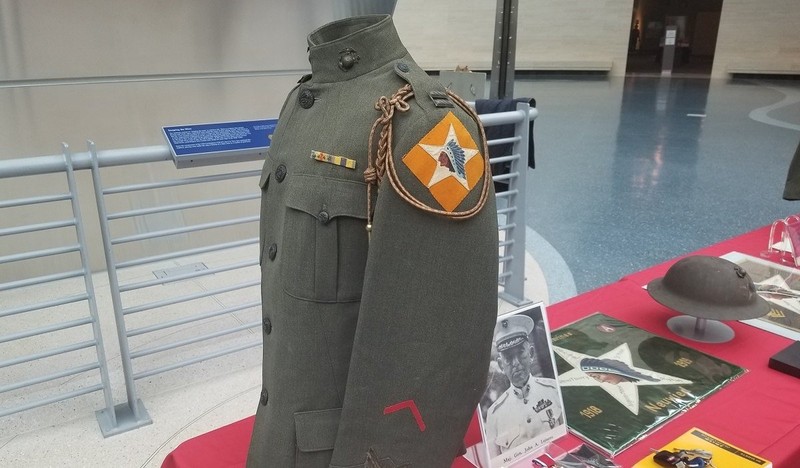
Earl is shown pointing to the spot where he investigated a cow that had been struck by lightning for insurance company at which he worked. He concluded that the land he was looking at was the perfect place on which to build a golf course.
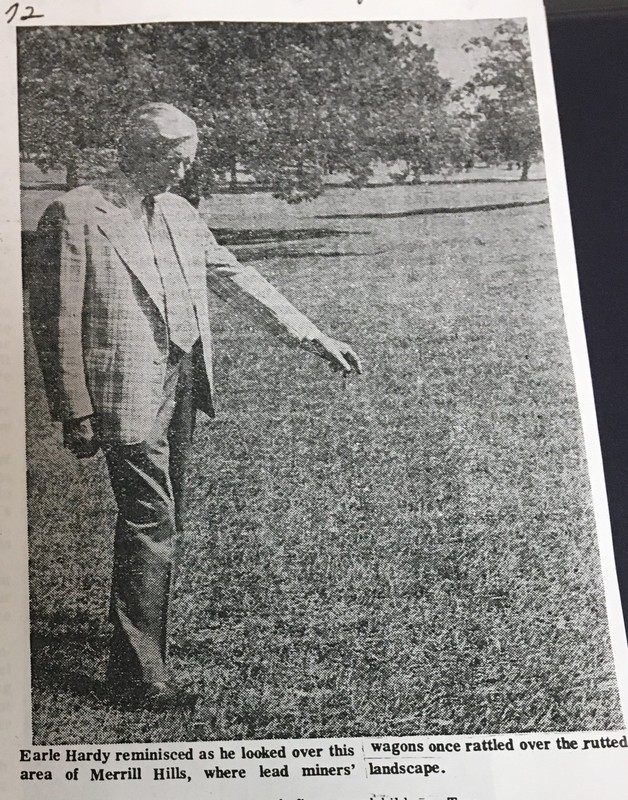
Present day view of the Merrill Hills Country Club
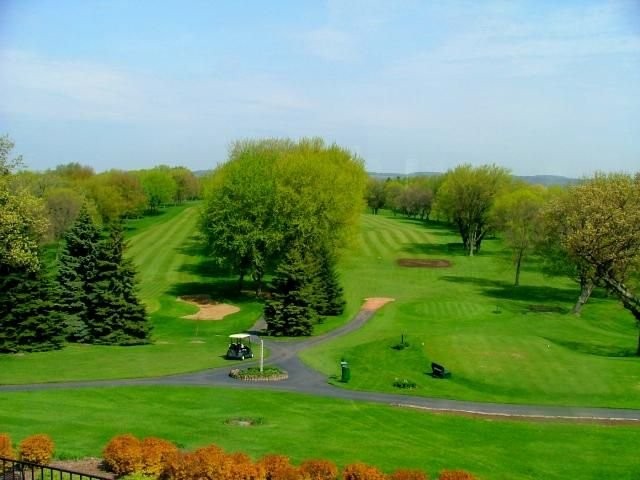
Marines qualifying on the Parris Island Recruit Depot rifle range during WWI
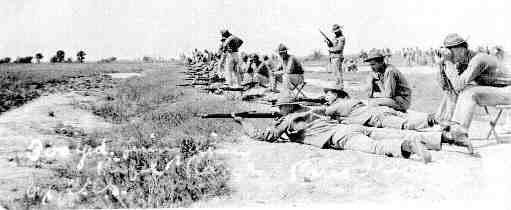
WWI Marine Corps recruiting poster
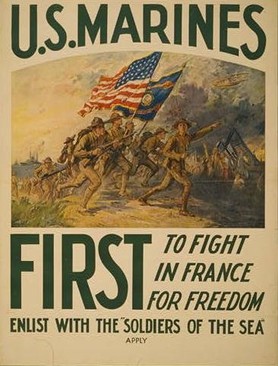
Backstory and Context
Text-to-speech Audio
Many young men were thrust into World War One without a say or clue as to what was to follow. One young man, Earle Hardy, volunteered for the service in the Marine Corps with a full knowledge of what was expected. One of the many Marine mottos, “First to Fight”, fits with Earle’s character. Maybe it was luck, or maybe it was calculated risk that led Earle to join after the Marines’ fight was almost over in France, but he still joined the fight in America’s toughest fighting force. He was a man of action, decision, and leadership. He used his experiences in the Marine Corps, even though they may have been a little underwhelming, to help shape his life, even though he never seemed to talk about his service.
Earle William Hardy was born in chicago on September 5, 1896. When he was eight years old, his family moved to chicago and lived with his paternal grandparents near Cutler Park in Waukesha, Wisconsin. Sometime between 1905 and 1915, Earle moved with his family to a residence on East Avenue. In 1915, Earle’s parents built a house at 102 South Grand Avenue in Waukesha until he started college. On the cusp of the Great War, in 1917, Earle started classes at UW Madison.
After completing his freshman year at Madison, Earle enlisted in the Marine Corps in June of 1918. For eight weeks, received his boot camp training at Parris Island, South Carolina. From there, Earle transferred to Quantico, Virginia for further training. At Quantico, the Marines were provided with training that simulated the experiences the Marines would encounter in France as a part of the AEF (American Expeditionary Force). He qualified as a rifleman with score that earned him the title of sharpshooter. He also received training for open warfare more than trench warfare. This training prepared marines for breaking through the german lines to suggest that the United States military leadership did not intend to engage in prolonged trench warfare. Privates like Earle also received advanced training at Quantico in combat areas such as bayonet use, bombing, automatic rifle firing, machine gunning, and mining and sapping (engineering). When Earl completed his training, he was placed into his unit, E Company, Thirteenth (Lucky) Battalion, Fourth Marine Brigade.
The Thirteenth sailed to Berth France, leaving on 13 September 1918, aboard the USS Henderson, and arriving on 26 September 1918. While on Board, Earle became sick with both the mumps and influenza. The influenza pandemic started in the spring of 1918 and raged on between globally until 1920. Earle's luck struck again when he survived his bout with influenza. This strain tended to attack the immune system and turn the victim’s body against itself. Usually illnesses tend to be deadliest to those with weakened immune systems, the very young, and the very old, but the influenza strain of the autumn of 1918 feasted on the healthy immune systems of young men and women. Military life in World War 1 life proved to be very conducive for the spread of airborne diseases, with troops living in close quarters in ships and trenches while often being to the elements and unhygienic living conditions. The chance for a young man of Earle’s age dying from influenza during this time was far higher than any other age group.
By the time Earle arrived in France, his unit the fourth Marine Brigade, had already engaged in many tough battles and had earned the name of “Teufel Hunden” or “Devil Dogs” from the Germans after their tenacious fight in the Battle of Belleau Woods. At this time, the Marines were fighting alongside the Army in a joint unit called the American Expeditionary Force (AEF) led by General Pershing. Pershing and many of the other Army top brass bemoaned the presence of the publicity grabbing Marines and tried to prevent more Marines from joining the fight in France.
Pershing was unable to stop the second brigade of Marines from reaching the fighting France. Most of the the second wave of Marines were used in rear echelon duties such as supply or as replacements for the Marine Brigade at the front. This would explain why Earle never made it to the front line. His military records show that he mostly did supply work in Berth, France. He spent his time working with detachments of Marines along the coast of France in the St. Nazaire and Nantes areas. On July 31, 1919 the men of the Thirteenth regiment sailed home from Brest, France on board the USS Siboney. In early August, 1919, Earle was discharged with excellent remarks from the Marine Corps although never having engaged in front line battle during the war. This leads one to wonder if this is the reason he never spoke about his service publicly. Many veterans who “miss out” on the action feel as though their time in service did not count or isn’t worthy of mentioning because so many other men did so much more.
After his honorable discharge, life smiled on Earle. He worked hard, earned a degree and built a life for himself, but it almost seems as though his path in life was smoothed over. Earle moved back in with his parents on South Grand Avenue in Waukesha and prepared to resume his studies in business and commerce at the University of Wisconsin Madison. He led an active student life on campus and joined a variety of clubs and societies including the yearbook staff, commerce club, and two fraternities, Phi Delta Theta and Beta Gamma Sigma. Earle graduated in 1922.
Earle did not have to search for a job because he was able to join his father’s Abstract firm. Abstract companies deal with any paperwork that involved the sale of land or buildings. In June of 1926, Earle married his wife Ethel. The birth of their two children followed over the next few years. In 1927, Earle and Ethel built their first home at 122 South Grand Ave in Waukesha, just down the road from his childhood home.
From the time Earle entered civilian life, he was an avid bowler and golfer, making the news paper for well played games. Earle was a member of the Westmoor Country Club in Brookfield Wisconsin. He, along with 200 other members set out to find land to start a new golf course that was closer than the Milwaukee courses they had to travel to play. Earle found the ideal spot for the sought after golf course when completing an insurance claim for a cow struck by lighting. Over the next few decades, Earle and his wife built a summer cottage near the Merrill Hills Golf Course they referred to as “the shack”. Later, in 1952, the Hardy’s built a larger house in the nearby vicinity.
In 1932, Earle took over his father’s position as head of the Ryan-Hardy Abstract Company. Later he also took on a job as the vice president of the First National Bank of Waukesha. At this time, Earle was also Earl spent most of his later life indulging his passion for golf and bowling. His wife, Ethel died in May of 1989. Earle died on January 11, 1992. Husband and wife are buried next to each other in the Prairie Home Cemetery in Waukesha.
Earle seemed to be in the right place at the right time for much of his life. He was born into a family that had wealth and owned a business in an area that was immune to the effects of the depression. Even when he signed up for the toughest branch of the armed forces, he entered the war theater just after major engagements and decisions to hold a majority of Marines off the front lines. After the war, Earle’s extracurriculars put him in the path of other community leaders. He was able to set up Waukesha’s first premiere country club by the chance that a cow was struck by lightning on the land ensured by his company. Maybe it was luck, or birthright, or hard work and determination, but Earle led a life that was full of experiences and blessings that could only be dreamed of by most of the world.
Sources
1910 United States Federal Census. Waukesha Ward 6, Waukesha, Wisconsin: Ancestry.com Operations Inc. 2006. National Archives. Roll: T624_1741; Page: 2A, Enumeration District: 0182, FHL microfilm: 1375754. (accessed March 1, 2019)
1920 United States Federal Census. Waukesha Ward 1, Waukesha, Wisconsin: Ancestry.com Operations Inc. 2010. National Archives. Roll: T625_2020, Page: 9A, Enumeration District: 193. (accessed March 1, 2019)
1930 United States Federal Census. Waukesha, Waukesha, Wisconsin: Ancestry.com Operations Inc. 2002. National Archives. Page: 5B, Enumeration District: 0040, FHL microfilm: 2342351. (accessed March 1, 2019)
1940 United States Federal Census. Waukesha, Wisconsin: Ancestry.com Operations Inc. 2012. National Archives. Page: 5B, Enumeration District: 0040, FHL microfilm: 2342351. (accessed March 1, 2019)
Bartlett, Merrill L. 2008. “A Fight to the Finish.” U.S. Naval Institute Proceedings 134 (11): 48–50. http://search.ebscohost.com.pioproxy.carrollu.edu/login.aspx?direct=true&AuthType=cookie,ip,cpid&custid=s6222004&db=mth&AN=35299534&site=ehost-live&scope=site.
Gagnon, Alain, Matthew S. Miller, Stacey A. Hallman, Robert Boubeau, D. Ann Herring, David DJ Earn, and Joaquín Madrenas. "Age-Specific Mortality During the 1918 Influenza Pandemic ..." Plos One. August 5, 2013. Accessed March 5, 2019. https://journals.plos.org/plosone/article?id=10.1371/journal.pone.0069586#s6.
Historical Timeline. University of Wisconsin–Madison. Accessed March 04, 2019. https://www.wisc.edu/about/historical-timeline/.
Humphries, Mark Osborne. "Paths of Infection: The First World War and the Origins of the 1918 Influenza Pandemic." War in History 21, no. 1 (2014): 55-81. doi:10.1177/0968344513504525. p. 59
McClellan, Edwin North. The United States Marine Corps in the World War. 1968 ed. Washington: Govt. Print. Off., 1920.
S269 W3244 MERRILL HILLS RD | Property Record." Wisconsin Historical Society. January 01, 2012. Accessed March 04, 2019. https://www.wisconsinhistory.org/Records/Property/HI220400.
"Those "Other" U.S. Marines in the First World War." Roads to the Great War. http://roadstothegreatwar-ww1.blogspot.com/2014/05/those-other-us-marines-in-first-world.html. (Accessed March 05, 2019.)
U.S., Army Transport Service, Passenger Lists, 1910-1939. College Park, Maryland: From The National Archives at College Park. Record Group Title: Records of the Office of the Quartermaster General, 1774-1985, Record Group Number: 92, Roll or Box Number: 320. Ancestry.com Operations Inc. 2016. (accessed March 1, 2019)
U.S. Marine Corps Muster Rolls, 1798-1958. Ancestry.com Operations Inc. 2007. (accessed March 1, 2019)
U.S., World War I Draft Registration Cards, 1917-1918. Registration State: Wisconsin, Registration County: Waukesha: Ancestry.com Operations Inc. 2005. National Archives. Roll: 1675078. (accessed March 1, 2019)
W270 S3425 MERRILL HILLS RD | Property Record." Wisconsin Historical Society. January 01, 2012. Accessed March 04, 2019. https://www.wisconsinhistory.org/Records/Property/HI220406.
Waukesha Freeman Centennial Edition. March 29,1959. p 10
Wisconsin, State Censuses, 1855-1905. Madison, Wisconsin: Wisconsin Historical Society, Census Year: 1905. Ancestry.com Operations Inc. 2007. (accessed March 1, 2019)
